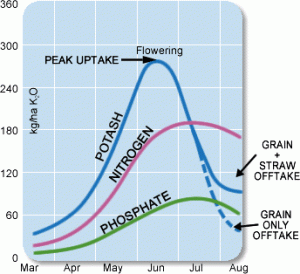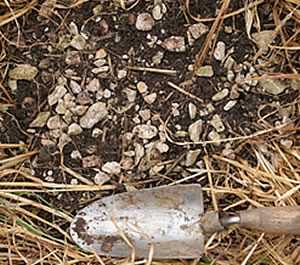Download pdf: Low soil P & K indices – Do they matter? Yes! (1.33M)
pdf 1.33M
Low soil P & K indices – Do they matter? Yes!
March 2017
The British Survey of Fertiliser Practice (Defra) shows that since the 1980s rates of Phosphate & Potash fertiliser applications have declined by 1/3 in arable crops, and 2/3 in grassland. With the increase in yields achieved in that time, there is a serious deficit in the P & K being applied from fertilisers, which is often not matched by nutrient supplies from applied organic manures.
Evidence for this comes from reports from the soil laboratories (PAAG Report 2016), which show that soil P & K levels are below target index in a staggering c.30% of samples.
With economic pressures, there has been much talk of farmers simply cutting out P & K applications, taking so called ‘PK holidays’. This scenario of inadequate soil K poses a serious threat to yields over a number of years, and means a more considered approach is needed.
The Problem

To attain full yield, good crop health and the best utilisation of nitrogen, modern crops with large green canopies must take up very substantial amounts of K to fill the sap. It has to approximately match the Nitrogen uptake. The peak K uptake is likely to be over 250 kg K2O/ha for cereals and over 300 kg K2O/ha for oilseed rape. As these crops ripen most of the K is no longer needed and returns down the stem into the soil and roots, so the actual offtake at harvest is significantly less than peak demand.
The soil needs to be able to supply enough K for the peak demand, and fast enough to match the rapid requirement, which is why having adequate soil K is so important.
Other crops such as grass silage, forage maize, potatoes, and sugar beet also have large peak demands for K, but the key difference with them, is that most of the K is removed at harvest (170-350 kg K2O/ha), so to maintain soil K indices, much larger applications – in fertilisers and manures – are required than for cereals.
If soil K is inadequate we cannot properly compensate simply by topdressing Potash, because the nutrient is not being mixed into the rooting zone. Topdressing can be a partial stopgap measure for the growing crop concerned, but it is not fully effective, especially in dry conditions. In reality, large additions need to be applied over several years to rebuild soil levels so that future crop yields are not limited.
A) What is the ‘target’ for soil K?
Given the importance of the soil K we need to clarify what the optimal level is and how suboptimal levels can be built.
The target index is set such that the soil K concentration does not hinder yield. It can not be predicted from theory, so it was based on many field trials for a large range of crops. These determined the soil concentration above which no crop yield response occurs, and hence peak demand is being fully satisfied. This level also has to be high enough to safely cope with seasonal variations, which may give difficult rooting and growing conditions, as well as any in-field soil variations. Seasonal variations may mean that slightly lower concentrations may work successfully sometimes, but they can not be relied on, hence we have the safe target level.
These field trials showed that for most crops and grassland index 2- (120-180 mg/kg) is sufficient, and that vegetable crops need index 2+. For potatoes, sugar beet and legumes index 2+ may be helpful too.
For shallow or stony soils, where the volume of actual soil is less than it appears, it is important that soils are high in index 2-, or even better in index 2+.
At target index, maintenance applications are required to replace crop offtake values. This ensures that soil levels do not decline and cause lower yields of future crops.
Looking ahead, it would be good to re-do these trials to see if they are still adequate for modern high yielding crops, which may well have even higher peak uptakes.
B) Raising low soil K levels to target (build policy)
We will now look at how soils of lower K index can be built to this optimum by applying extra Potash each year, in addition to the replacement of the crop offtake at harvest (maintenance). These applications can be as fertiliser and/or manures.
The current RB209 uses a simple system of adding 30 kg K2O/ha to the offtake requirement at index 1 and adding 60 kg K2O/ha at index 0, every year until target index 2- is reached. This is a slow approach taking 10-15 years to reach target index 2-.

The new RB209, to be launched in May, recognises that this is a long period to be suffering lower yields, and that it does not take into account the different amounts required to build indices on different soil types. It directs users to PDA’s PK Calculator which offers an alternative system for a more bespoke and rapid build policy. It works out the build rate and the maintenance amount for the crop entered for each year.
The PK Calculator can be freely and simply used on our website (www.pda.org.uk) or downloaded as an App to handheld devices. It calculates the build rates, taking into account the soil type and it allows the user to determine the number of years to achieve target index. The speed of build which is most likely to be efficient, is around 4-5 years. It is not recommended to apply all the build in 1 or 2 years because it takes time for the varying pools of K availability to adjust and equilibrate in the soil. For this reason too, re-sampling the soil should not be done too soon after these large applications.
Where organic manures are used to supply the build, then larger amounts can be applied because of the slower release. However, in practice, other nutrients usually determine the application rate for manures.
Two aspects to check are:-
- Shallow and stony soils may need less Potash to build the K index because they contain less soil.
- Very light sandy soils can not hold much K, due to their low Cation Exchange Capacity (CEC). They may never be able to reach and maintain target index 2-, so attempting to do so is not worthwhile, and lower yields are likely. The Potash applications should be split between the autumn seedbed and spring topdressing. This policy also helps reduce leaching of K, which can occur on these light soils.

C) Utilising the surplus K in high index soils (rundown policy)
The current RB209 gives simple guidance on this: at index 2+ it deducts 30 kg K2O/ha each year from the crop offtake (maintenance), and at index 3 or 4 simply says apply no Potash, until target is reached. In some circumstances where crop offtakes are high, the latter policy carries risks of soil K falling too low over the usual 4 year soil sampling period, and so a more controlled approach is discussed here.
Again, running down too rapidly means that the transfer of less available K to more available K in the soil does not have time to occur, and temporary shortages can occur hindering plant uptake and yield. The table below gives some guidance on how much it takes to lower the soil index to target.
| Table: Suggested total rundown allowances, kg K2O /ha | ||||
| Soil exchangeable K mg/l & index | ||||
| Soil type | 210 2+ |
280 3- |
360 3+ |
440 4 |
| Sandy | Nil | -90 | -220 | |
| Stony | -55 | -160 | -280 | -400 |
| Normal | -85 | -240 | -420 | -600 |
| Heavy | -155 | -400 | -700 | |
This shows that, if no Potash is applied, an average yielding wheat crop, with straw baled, (removing 83 kg K2O/ha) could reduce a normal 2+ soil to target index 2- in only one year. This is why care is needed with run-down policies.
The rundown value shown should be split over 3 or 4 years. e.g. at index 2+ for a normal soil, the -85 kg K2O/ha could comprise a deduction from crop offtake (maintenance) of 22 kg K2O/ha per year over 4 years, or 27 kg K2O/ha over 3 years.
For crops with large offtakes, the index will rundown even more quickly, if no Potash is applied. This is especially true for maize, potatoes, fodder beet, and especially multi cut silage, where harvest coincides with peak uptake by the grass. In such cases, significant Potash applications should be made each year, and soil sampling may be more frequent (e.g. 3 years).
For crops with low offtakes, such as oilseed rape and cereals (grain only), deducting the annual rundown may give a figure too low to be worth applying, and in these cases it is sensible to omit the Potash for a couple of years, but it is important to re-sample then.
As always, it is best to keep a nutrient balance calculation over the years concerned. This will calculate the offtakes against applications and keeps a check on the rundown process, and should reduce surprises when sampling.
Finally
This article addresses the concerns and questions asked by many farmers and agronomists on the matter of builds and safe rundowns, and minimising the shock of unexpected falls in soil Potash. Computerised systems make keeping a nutrient balance very straightforward and FACTS Qualified Advisers usually do this for their clients. Our PDA leaflets showing values of P & K offtakes and P & K content of manures are on our website www.pda.org.uk or they can be sent to you on request.

